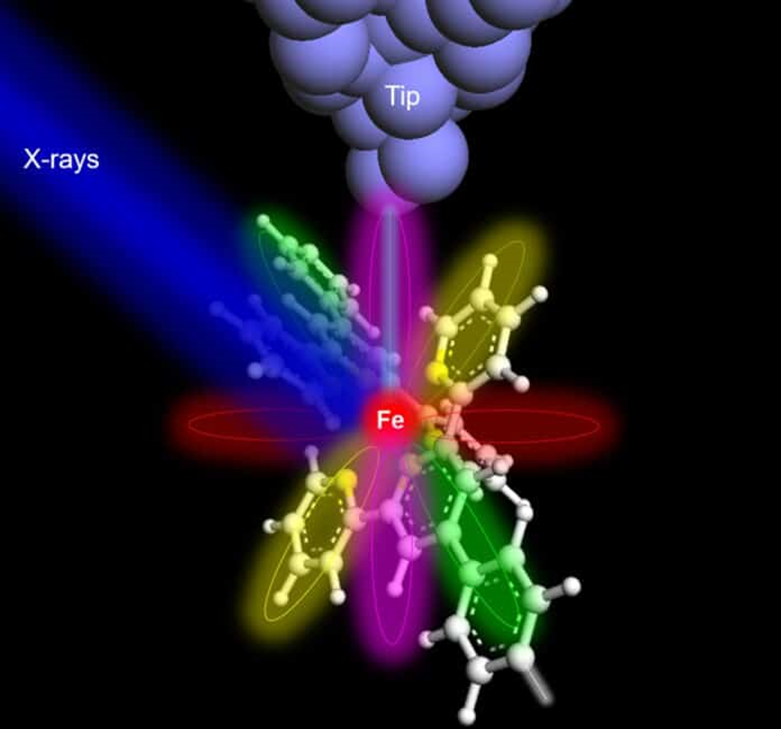World first: scientists manage to perform the first x-ray of a single atom!

An atom consists of a nucleus around which electrons gravitate. Credits: Igor Batrakov/Shutterstock
Researchers have achieved a world first: the x-ray of a single atom! For this, they have notably created a new technology which is based, among other things, on X-rays, it is synchrotron X-ray tunneling microscopy or SX-STM which makes it possible to better understand the behavior of electrons. in atoms.
A first x-ray of a single atom! According to a study published in Nature , a team of scientists from the American universities of Ohio and Illinois-Chicago and the Argonne National Laboratory have just revealed the incredible image of a single atom. They achieved this feat by using an essential tool in many medical and scientific fields. It's X-rays!
A Revolutionary Advance in Single Atom X-Rays
Atoms are the smallest parts of a simple body. They constitute all the solid, liquid and gaseous substances that surround us. We ourselves are made up of atoms. These atomic particles are extremely small. For example, the diameter of a hydrogen atom is estimated at 0.5 x 10-10 meters, that is to say approximately one million times smaller than the diameter of a human hair. And the nucleus of the atom is about 100,000 times smaller than the atom itself. In other words, observing atoms is very difficult!

Physicist Wilhelm Röntgen (1845-1923) discovered X-rays in 1895. This is high-frequency electromagnetic radiation. It consists of photons with an energy ranging from a hundred eV (electronvolt) to several million eV (MeV). X-rays are characterized by their ability to pass through matter while being partly absorbed. This absorption is a function of the density of the material traversed and of the energy of the X-rays which traverse it. The applications of X-rays are numerous. They are used in medical imaging, crystallography and astrophysics.
X-rays can therefore theoretically be used to radiograph atoms. However, until now, the signal produced by a single atom crossed by X-rays is too weak and difficult to distinguish from background noise. But researchers have already succeeded in using X-rays to X-ray a set of 10,000 atoms.
American researchers have just achieved a real feat by succeeding for the first time in the world in x-raying a single atom!

Synchrotron X-ray scanning tunneling microscopy
To characterize matter by X-rays, it is essential to have a large number of atoms. For several years now, researchers have been trying to reduce this quantity by developing technologies such as synchrotron X-ray sources. These have made it possible to radiograph a quantity corresponding to the 10,000 atoms mentioned above in this article.
Some microscopes, called scanning probe microscopes , already allow individual atoms to be imaged today. To do this, they are mapped onto the surface of a material using an extremely fine tip.
The new technology developed with X-rays allows a considerable advance in identifying the type of a single atom and even its chemical state. The development of this technique required 12 years of work. It is called synchrotron X-ray scanning tunneling microscopy or SX-STM. As for the conventional X-ray detector, they have been replaced by an extremely sharp metal point allowing closer approach to the sample.

It is an imaging technique that combines the chemical, magnetic and structural sensitivity of X-rays with the incredible capability of scanning probe microscopy. This technology is mainly used for imaging and characterizing materials at the nanometric scale.
The principle of this method is as follows. The electrons closest to the nucleus of the atom are excited by a flux of X-rays. These excited electrons then emit a unique fingerprint called the absorption spectrum. The latter makes it possible to identify the type of chemical element present in the material.
Being able to predict the behavior of electrons in atoms
Caption: In this video, discover the principle of the scanning tunneling microscope.
Credits: The Blob/YouTube
The signal can only be detected when the metal detector tip is positioned just above the atom to be studied and as close as possible to it. This is therefore a detection method localized at the atomic level.
The research team made this x-ray of a single atom. For this, she used two metallic chemical elements: iron (Fe) and terbium (Tb). The absorption spectra obtained correspond perfectly to the iron and terbium atoms.
The researchers also used another technique called X-ERT resonance or “X-ray excited resonance tunneling”. This technique makes it possible to always detect, thanks to synchrotron X-rays, the way in which the atomic orbitals of all the atoms constituting a molecule are oriented on the surface of a material. By knowing the orientation of atomic orbitals , which represent a probability of an electron being present in a given area around the atomic nucleus, scientists can predict the behavior of electrons.
The researchers used these two techniques to detect the X-ray signature of an individual atom. They have thus just paved the way for exciting new research in many fields such as quantum properties and the magnetic properties of individual atoms.
Source : websites

